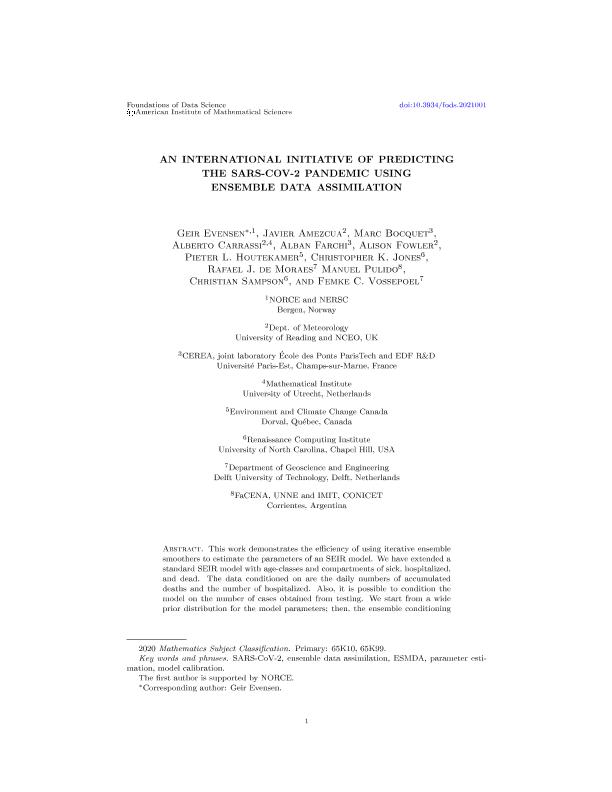Artículo
An international initiative of predicting the SARS-CoV-2 pandemic using ensemble data assimilation
Evensen, Geir; Amezcua, Javier; Bocquet, Marc; Carrassi, Alberto; Farchi, Alban; Fowler, Alison; Houtekamer, Pieter L.; Jones, Christopher K.; de Morales, Rafael J.; Pulido, Manuel Arturo ; Sampson, Christian; Vossepoel, Femke C.
; Sampson, Christian; Vossepoel, Femke C.
 ; Sampson, Christian; Vossepoel, Femke C.
; Sampson, Christian; Vossepoel, Femke C.
Fecha de publicación:
01/2021
Editorial:
American Institute of Mathematical Sciences
Revista:
Foundations of Data Science
ISSN:
2639-8001
e-ISSN:
2639-8001
Idioma:
Inglés
Tipo de recurso:
Artículo publicado
Clasificación temática:
Resumen
This work demonstrates the efficiency of using iterative ensemble smoothers to estimate the parameters of an SEIR model. We have extended a standard SEIR model with age-classes and compartments of sick, hospitalized, and dead. The data conditioned on are the daily numbers of accumulated deaths and the number of hospitalized. Also, it is possible to condition the model on the number of cases obtained from testing. We start from a wide prior distribution for the model parameters; then, the ensemble conditioning leads to a posterior ensemble of estimated parameters yielding model predictions in close agreement with the observations. The updated ensemble of model simulations has predictive capabilities and include uncertainty estimates. In particular, we estimate the effective reproductive number as a function of time, and we can assess the impact of different intervention measures. By starting from the updated set of model parameters, we can make accurate short-term predictions of the epidemic development assuming knowledge of the future effective reproductive number. Also, the model system allows for the computation of long-term scenarios of the epidemic under different assumptions. We have applied the model system on data sets from several countries, i.e., the four European countries Norway, England, The Netherlands, and France; the province of Quebec in Canada; the South American countries Argentina and Brazil; and the four US states Alabama, North Carolina, California, and New York. These countries and states all have vastly different developments of the epidemic, and we could accurately model the SARS-CoV-2 outbreak in all of them. We realize that more complex models, e.g., with regional compartments, may be desirable, and we suggest that the approach used here should be applicable also for these models.
Palabras clave:
SARS-COV-2
,
ENSEMBLE DATA ASSIMILATION
,
ESMDA
,
MODEL CALIBRATION
,
COVID-19
Archivos asociados
Licencia
Identificadores
Colecciones
Articulos(IMIT)
Articulos de INST.DE MODELADO E INNOVACION TECNOLOGICA
Articulos de INST.DE MODELADO E INNOVACION TECNOLOGICA
Citación
Evensen, Geir; Amezcua, Javier; Bocquet, Marc; Carrassi, Alberto; Farchi, Alban; et al.; An international initiative of predicting the SARS-CoV-2 pandemic using ensemble data assimilation; American Institute of Mathematical Sciences; Foundations of Data Science; 3; 2021; 1-2021; 1-65
Compartir
Altmétricas



